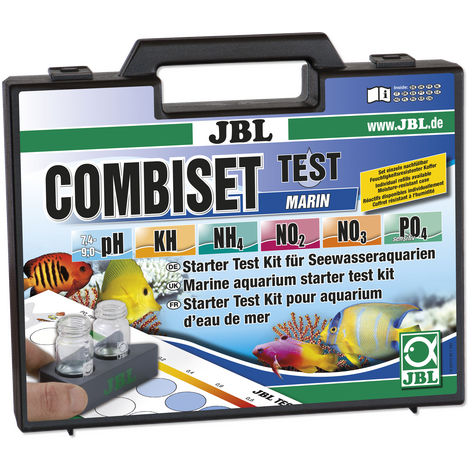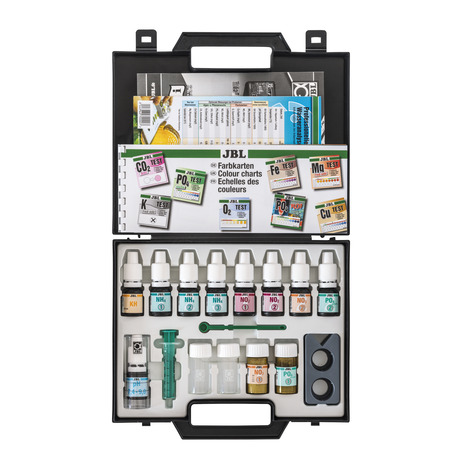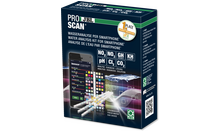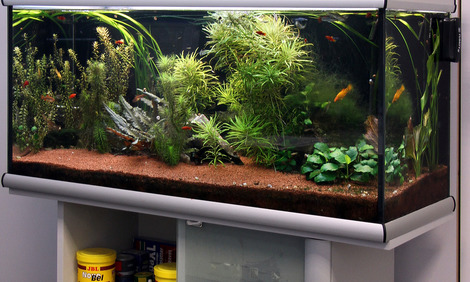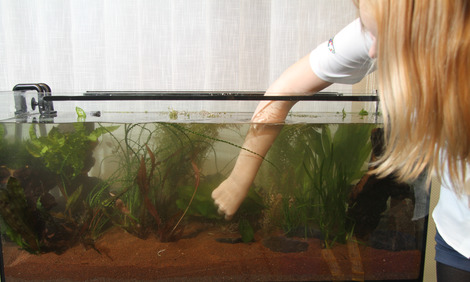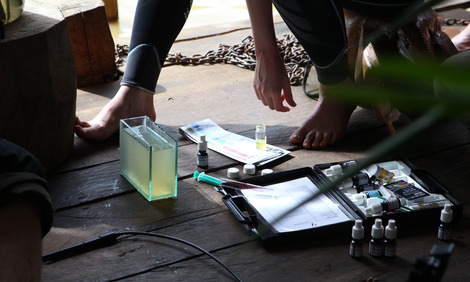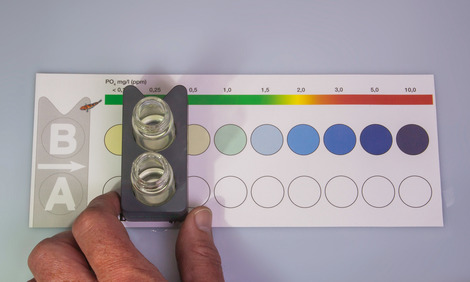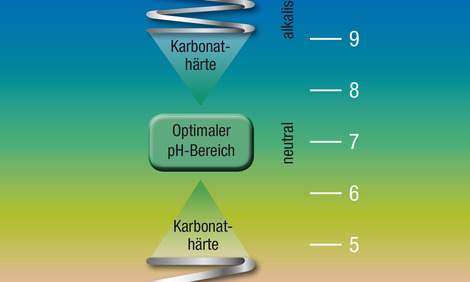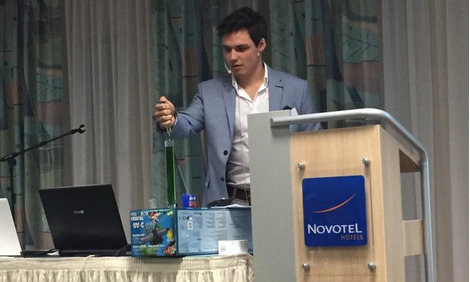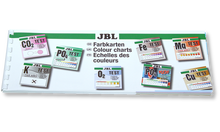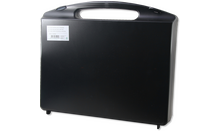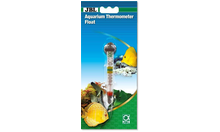W fazie początkowej akwarium morskiego należy mierzyć te parametry wody codziennie do maks. raz na tydzień, aby zobaczyć, jak dobrze działa akwarium i kiedy można wpuścić zwierzęta. Twardość węglanowa pokazuje, jak woda jest stabilna pod względem pH i powinna być pomiędzy 7 i 10 °dKH. Amon jest pierwszym etapem rozkładu azotu i przy wartościach pH powyżej 7 staje się coraz bardziej toksycznym amoniakiem. Zawartość amonu może wynosić maks. 0,25 mg/l. Zawartość azotynów pokazuje, czy ta trucizna dla ryb jest w akwarium. Azotyny powinny być zawsze w ilości poniżej 0,2 mg/l. Azotany i fosforany służą glonom jako pożywienie. Zawartość azotanów powyżej 20 mg/l i zawartość fosforanów powyżej 0,1 mg/l może prowadzić do nadmiernego rozrostu glonów. Przy niskich wartościach azotanów i fosforanów wiele rodzajów koralowców rośnie znacznie lepiej, ponieważ w ich tkankach żyją endosymbiotyczne glony (zooksantelle).
W laboratorium JBL Online mogą Państwo bezpłatnie analizować zmierzone parametry wody i uzyskać zalecenia.
JBL TestCombi Set Marin
Podstawowa walizka do testów do akwariów morskich
PROAQUATEST COMBISET Marin
- 6 Testów wody do prostego i dokładnego określania najważniejszych parametrów wody morskiej, szczególnie do akwariów z rybami
- Dodać wskaźnik barwiący i porównać z kartą barw lub policzyć krople, do momentu zmiany koloru
- W zestawie test na twardość węglanową, wartość pH, amon/amoniak, azotyny, azotany i fosforany
- System porównawczy upraszcza porównanie kolorów i uwzględnia także własne zabarwienie wody
- W zestawie: 6 testów wody, blok porównawczy, 3 kuwety, strzykawka, łyżeczka miarowa, karty barw, karty protokołów i instrukcja
To mogłyby także Panią/Pana zainteresować
JBL TestCombi Set Marin
Właściwości
| Gatunek zwierzęcia: | Koralowce, Małże, Nurkowanie za żerem, Ślimaki |
| Wielkość zwierzęcia: | Dla wszystkich wielkości zwierząt |
| Grupa wiekowa zwierząt: | Wszystkie ryby akwariowe |
| Pojemność Siedlisko: | Do wszystkich akwariów |
| Kolor: | wielobarwny |
| Dozowanie: | patrz instrukcja obsługi |
Etykieta elektroniczna / Żarówki
| Rtęć: | Nie |
| Możliwość ściemniania: | Nie |
Have you lost your record sheets, already filled them all in or do you need them in another language?
With the following links you can quickly and easily print out your new record sheets with recommendations for the individual parameters at home and document the water analyses.
deutsch: https://www.jbl.de/?lang=de&mod=files&func=show&id=11164
English: https://www.jbl.de/?lang=en&mod=files&func=show&id=11164
französisch: https://www.jbl.de/?lang=fr&mod=files&func=show&id=11164
niederländisch: https://www.jbl.de/?lang=nl&mod=files&func=show&id=11164
The colour cards are not available for download on the JBL website. The absolutely accurate colour reproduction that is required can only be achieved using a printer which can be re-calibrated before each printout. Most privately used printers are not accurate enough for this.
You will find the colour chart bundle as a spare part on the respective product page and in the spare parts shop under: https://www.jbl.de/en/products/detail/8732/jbl-proaquatest-assortiment-color-chart
The tests from the test range: JBL GH test, JBL KH test, JBL calcium test Ca and JBL magnesium test Mg, where the number of drops are counted until the colour changes and the counted value is multiplied by a value:
GH = number of drops = general hardness in °dH
KH = number of drops = carbonate hardness in °dH
CO2 = number of drops * 2 = CO2 in mg/l
Magnesium + calcium = number of drops * 120 = amount Ca + Mg in mg/l
Calcium = number of drops * 20 = amount Ca in mg/l
Magnesium = amount Ca+Mg from magnesium test - amount Ca in mg/l = magnesium in mg/l
The colour charts are intended to be used with the comparator block. In addition, when the comparator block is used with the blank water sample, this compensates the inherent water colour.
Therefore, if the comparator block is not used, there will most likely be deviations in the readings.
If one of your measurements reaches the end of the colour chart scale you can multiply the scale by diluting later tests with distilled water (e.g. JBL Dest).
Here’s how to do it: dilute the sample with distilled water and carry out the test once more.
This works in detail as follows:
GH test: Instead of 5 ml use 10 ml aquarium water. Now 1 drop is equivalent to 0.5 dGH.
KH test: Instead of 5 ml use 10 ml aquarium water. Now 1 drop is equivalent to 0.5 dGH.
Note: when using 10 ml sample water the colour development is weaker with the first drops than with 5 ml sample water. Put the measuring container on a white underlay for a better readability.
NH4/NH3 ammonium/ammonia, NO2 nitrite, Fe iron and Cu copper:
2.5 ml sample + 2.5 ml dist. water: result times 2
1 ml sample + 4 ml dist. water: result times 5
0.5 ml sample + 4.5 ml dist. water: result times 10
NO3 nitrate, SiO2 silicate, PO4 phosphate sensitive and Mg magnesium freshwater:
5 ml sample + 5 ml dist. water: result x 2
2 ml sample + 8 ml dist. water: result x 5
1 ml sample + 9 ml dist. water: result x 10
PO4 phosphate koi high range:
2.5 ml sample + 2.5 ml dist. water: result x 2
1 ml sample + 4 ml dist. water: result x 5
K potassium:
7.5 ml sample + 7.5 ml dist. water: result x 2
3 ml sample + 12 ml dist. water: result x 5
1.5 ml sample + 13.5 ml dist. water: result x 10
K potassium in marine water:
1. Fill 10 ml of sample water with distilled water to 300 ml.
2. Follow the instructions for fresh water.
3. Multiply the test result by a factor of 30.
CO2 direct, Ca calcium and Mg+Ca magnesium+calcium: not required.
We repeatedly receive questions regarding the symbols on the water test. The hobby areas cannot be clearly assigned to the scales for analysis. There are three symbols to make the hobby areas on the colour charts clear:
Discus = fresh water
Emperor = salt water
Koi = garden pond
In the following, you will find a list which assigns the scale for analysing the results from measurements in the hobby area and explains the symbols: The scales are described from the top to the bottom here.
NO3: salt water, fresh water, garden pond
pH 6.0 – 7.6: fresh water, garden ponds
pH 7.4 – 9.0: salt water, fresh water, garden pond
Fe: fresh water, garden pond
The following JBL tests have a uniform scale for all 2 or 3 hobby areas for analysis of the results from the measurements, as differentiation is no longer necessary:
SiO2
Cu
NH4
NO2
PO4
pH 3-10
O2
Basically a sealed test keeps longer than an open one. How much the shelf life is reduced depends crucially on the handling and the storage conditions of the reagents. It may happen that a reagent in a test that has been open for 9 months doesn’t indicate correctly any more. However, additional information is needed to answer this question properly.
-
Do pobrania
JBL TestCombi Set Marin
-
Do pobrania
Wskazówki dotyczące bezpieczeństwa dla testów Testlabs
-
Nazwa pliku:safety_instructions_Testlabs.pdf
-
-
Do pobrania
JBL Test Combi Set Marin
-
Do pobrania
JBL TestCombi Set Marin
